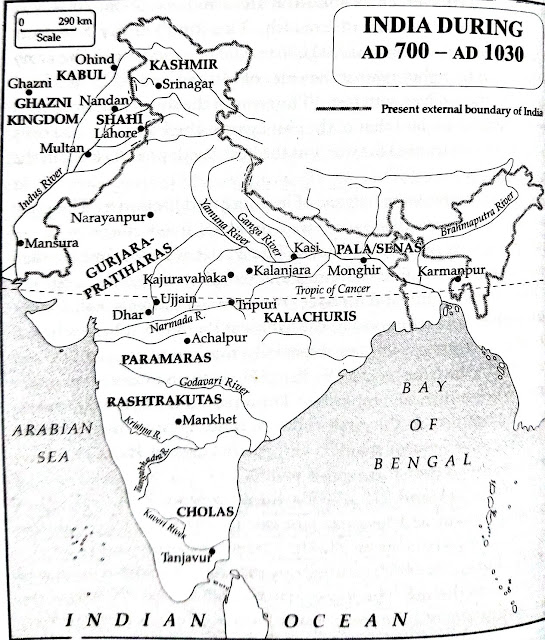- Pratiharas are also called Gurjara-Pratiharas.
- They ruled Kanauj for a long time (almost a century).
- They ruled over central and eastern parts of Rajasthan.
- They Clashed with Rashtrakutas over Malwa and Gujarat and later over Kannauj.
- Nagabhata-I, the first Pratihara king offered resistant to the Arab rulers of Sindh who tried to encroach over Rajasthan, Gujarat, the Punjab etc.
- The Pratihara's effort of gaining upper Ganga valley and Malwa were defeated by the Rashtrakuta rulers - Dhruva and Gopala III.
- Bhoja or Mihir Bhoja was the real and the greatest ruler of the Pratihara dynasty.
- He took the title of 'Adivaraha' as he was the devotee of lord Vishnu.
- Bhoja recovered Kannauj in 836 AD and made it the capital.
- His ambition to expand to the east was failed by Pala ruler Devapala. But after Devapala's death, Bhoja succeeded in extending his rule to the eastern parts of India.
- Bhoja died in 885 AD.
- He was succeeded by his son, Mahendrapala-I who ruled till 908-09 AD.
- Mahendrapala-I extended the kingdom up to Magadh and North Bengal.
- He was defeated by Kashmir's king in a battle, and the first ceded some territory to the later.
- The Pratiharas imported horses from central Asia and Arabia. They had the best cavalry at the time.
- Al-Masudi, a native of Baghdad visited Gujarata in 915-16 AD. He gives account of the prestige of the Pratihara rulers.
- According to Al Masudi, Pratihara kingdom had following features -
- 1,80,000 villages, cities, rural areas and was about 2000 km in length and 2000 km in breadth.
- King's army had four divisions each consisting of 7,00,000 to 9,00,000 men. With the army of the north he fought against rulers of Multan and other Muslims, with the army of south he fought against the Rashtrakutas, and that of the east against the Palas.
- They had the best cavalry in the country.
Learning and literature
- The great poet and dramatist - Rajashekhar, lived in the court of Mahipala, a grandson of Bhoja.
- Pratiharas built many fine buildings and temples in Kannauj.
- During the Pratihara period, many Indian scholars went to Baghdad and Arab world and introduced Indian science, algebra, medicine there.
- Despite hostility with Arab rulers of Sindh, there were movements of Indian scholars and goods in the Western Asia during the period.
- Rashtrakuta king Indra-III attacked and devastated the city of Kannauj. This weakened the Pratiharas and Gujarat went into the hands of Rashtrakutas.
- The Pratiharas were left with no access to the sea as a result of fall of Gujarat. This further weakened their overseas trade with Central Asia.
- Rashtrakuta King Krishna-III invaded the Pratiharas in the north in 963. This lead to the dissolution of the Pratihara empire.
Also read the following:-


Comments
Post a Comment